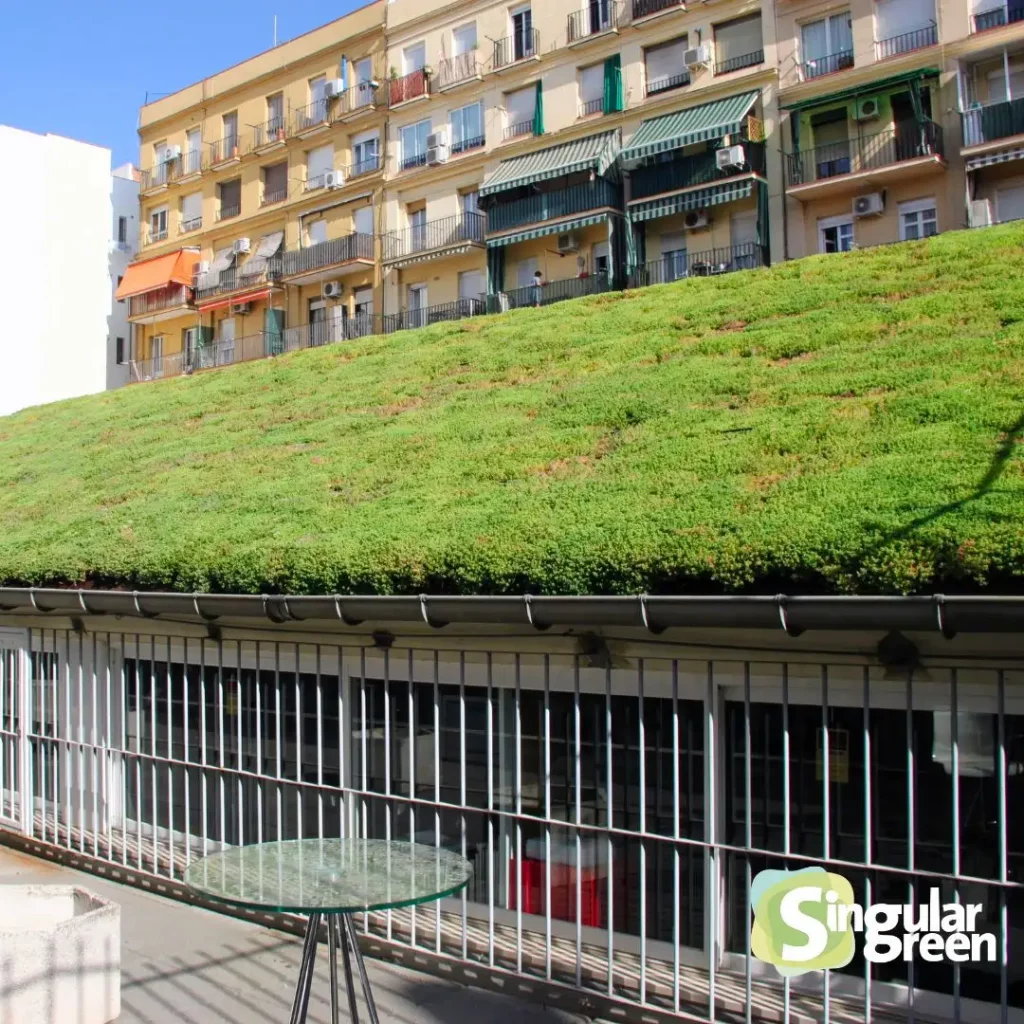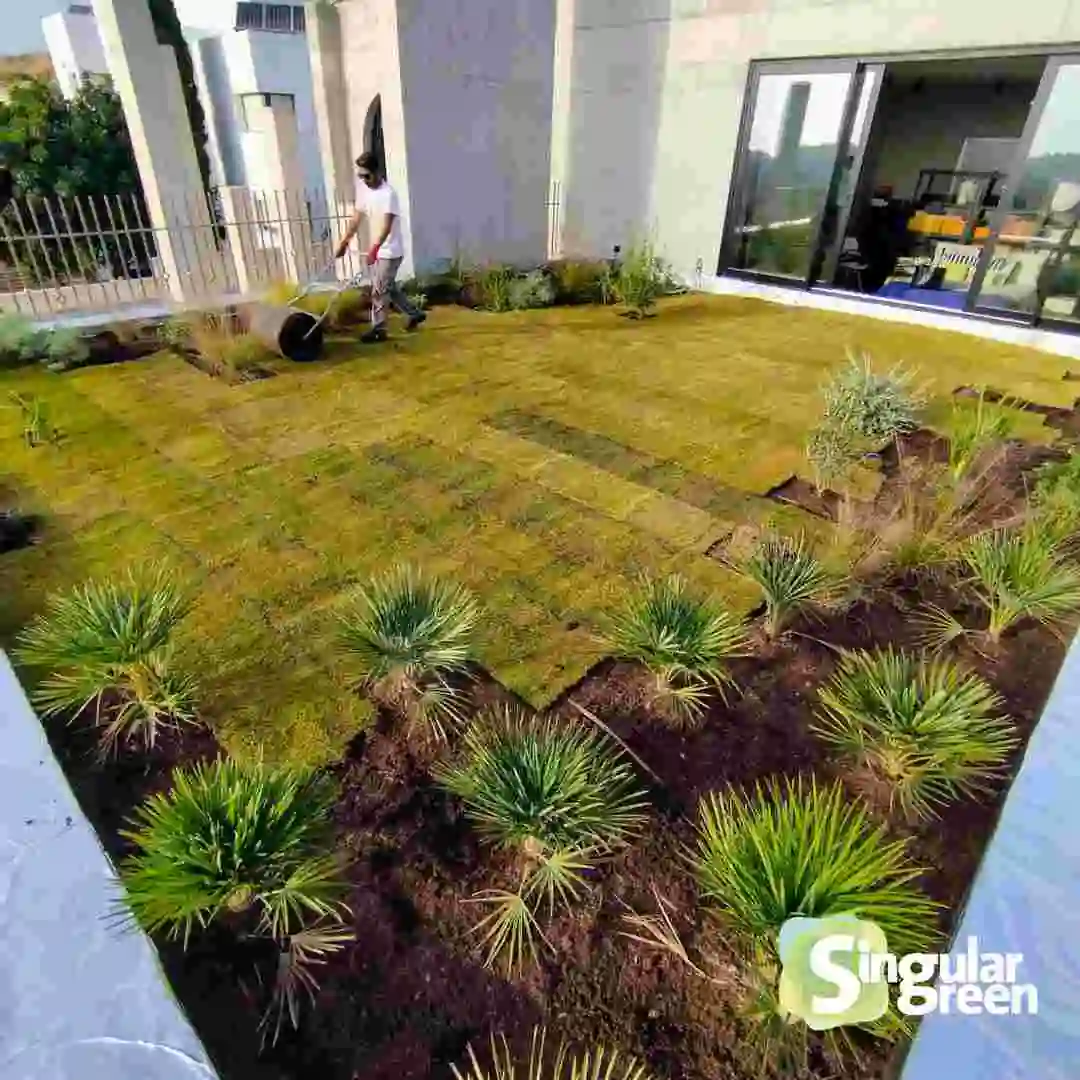The Green Factor is an innovative initiative approved by Madrid City Council that seeks to integrate nature into all new buildings and renovations in the city.
This regulation is an important step towards creating a more sustainable and liveable city. Its main objective is to increase the green surface, reduce the heat island effect, improve air quality and promote urban biodiversity.
At SingularGreen, we have had the opportunity to work on the implementation of the Green Factor in several projects.
This experience has allowed us to observe first-hand both the benefits and challenges of this regulation.
We applaud the City Council’s initiative, as we strongly believe in the importance of integrating nature into urban buildings.
Objectives of the Green Factor
The Green Factor was introduced as part of Madrid City Council’s overall plan to address urban environmental problems.
The motivation behind this initiative is clear: to increase the amount of green spaces in the city to mitigate the heat island effect, improve air quality and provide habitats for urban wildlife.
The Green Factor concept is not unique to Madrid; other cities such as Barcelona and Gandía have also implemented similar regulations.
However, the Madrid version is particularly ambitious, requiring a minimum amount of green space in all new buildings and renovations, adapted to the type of construction, whether commercial, residential or otherwise.
Elements of the Green Factor: Nature-Based Solutions
The Green Factor sets out a number of elements of nature-based solutions that score towards compliance.
These elements include landscaped areas, shaded areas, green roofs and vertical gardens. Each of these components has a specific value in terms of its contribution to the Green Factor.
3.1. Landscaped areas
Landscaped areas are one of the most common and effective elements in meeting the Green Factor. These areas can include both ground level gardens and landscaped terraces.
Proper implementation of these areas can provide recreational spaces for residents and improve the aesthetics of the urban environment.
3.2. Shading areas and trees
Trees are a crucial component of the Green Factor because of their ability to create shaded areas and significantly reduce the heat island effect.
Trees act as natural air conditioners, using the process of evapotranspiration to cool the surrounding air.
In addition, trees are excellent for urban biodiversity, providing habitats for birds and other animals.
3.3. Green roofs
Green roofs are another popular solution. They not only improve the aesthetics of the building, but also offer thermal benefits, helping to keep buildings cooler in summer and warmer in winter.
At SingularGreen, we have found that a well-designed green roof can transform an underutilised space into a valuable common area for residents.


3.4. Vertical gardens
Vertical gardens, or green facades, are an innovative option that scores high on the Green Factor.
Although they may cost more to implement, the benefits in terms of biodiversity and aesthetics are significant.
Vertical gardens can bring nature into urban spaces where horizontal options are limited.


Benefits of the Green Factor for the City
The implementation of the Green Factor in Madrid brings with it numerous benefits that go beyond simple aesthetics.
4.1. Reduction of the heat island effect
One of the most important benefits is the reduction of the heat island effect.
Green areas help to cool the surrounding air, which can lead to lower temperatures in densely populated urban areas.
This not only improves the comfort of residents, but can also reduce the need for air conditioning and thus energy consumption.
4.2. Increasing urban biodiversity
Increasing green space provides habitats for diverse species of flora and fauna, which in turn increases urban biodiversity.
This is crucial for maintaining healthy and balanced ecosystems in cities.
4.3. Improving air quality
Plants and trees act as natural filters, absorbing pollutants and producing oxygen.
This can significantly improve air quality in urban areas, which is beneficial for public health.
Practical Implementation of the Green Factor: Case Studies
At SingularGreen, we have worked on several projects that have successfully implemented the Green Factor.
One notable example is an office building in the centre of Madrid, where a green roof was created that not only complies with regulations, but also provides a recreational space for employees.
Another case is a residential development where vertical gardens were integrated into the facades.
These gardens not only improve the aesthetics of the building, but also help to regulate the temperature and provide a healthier environment for the residents.
Challenges and Considerations in Implementing the Green Factor
While the Green Factor brings many benefits, it also presents certain challenges.
At Singular Green, we have found that one of the biggest obstacles is the need to comply with regulations in the most cost-effective way possible.
However, this mentality can lead to implementations that do not take full advantage of the potential benefits of green space.
It is essential that architects and developers see the Green Factor not just as an obligation, but as an opportunity to enhance the value of their projects.
Implementing green solutions effectively can increase the value of the property and improve the quality of life of its users.
Recommendations for Effective Green Factor Implementation
To ensure that the Green Factor is implemented effectively and maximises its benefits, we recommend the following strategies:
- Early planning: Include the Green Factor from the initial stages of project design.
- Proper plant selection: Use plants appropriate to the climate and urban environment to ensure their survival and effectiveness.
- Ongoing maintenance: Plan and budget for regular maintenance of green spaces to ensure their longevity and functionality.
- Involve the community: Promote the participation of residents in the care and use of green spaces to increase their sense of ownership and care for the environment.
Conclusion: The Future of Factor Verde in Madrid
The Factor Verde represents a significant step towards a more sustainable and liveable city.
While its implementation may present challenges, the long-term benefits are undoubted.
At SingularGreen, we believe it is essential to approach these projects with a long-term vision and a commitment to quality and sustainability.
As more cities adopt similar regulations, we are likely to see an increase in urban quality of life and a reduction in environmental problems.
The Green Factor is not only an environmental necessity, but also an opportunity to build a healthier and more sustainable future for all.






